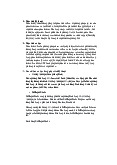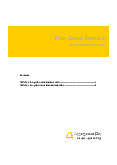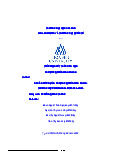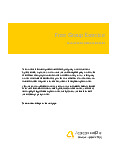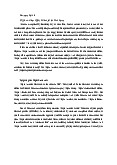



















Preview text:
COURSE OUTLINE Course ID Course tittle Credits MK302DE01 International Marketing 3
(To be applied to: ❍ Main Semester ❍ Extra Semester - …, School year: from …..)
A. Course Specifications Periods Periods in classroom Total Lecture/ Laboratory/ Self-study Lecture Lab periods Seminar Studio Activity Fieldwork periods room room Fieldwork (1) (2) (3) (4) (5) (6) (7) (8) (9) 45 39 0 0 6 90 39 0 6
(1) = (2) + (3) + (4) + (5) = (7) + (8) + (9) B. Other r elated Subjects Pre-requisites Principles of Marketing Co-requisites Not compulsory
Students those are used to study foundation subjects, such as:
micro – economics, macroeconomics, consumer behaviors, Other required
strategic management, integrated marketing communication
(IMC) and foreign trade are more beneficial in term of learning this subject. C. Course Description 1
This course explores the development of international marketing programs from the
determination of objectives and methods of organization through the execution of research,
advertising, distribution, and production activities. Students examine the international
similarities and differences in marketing functions as related to the cultural, economic,
political, social, and physical dimensions of the environment. Students also consider the
changes in marketing systems and the adoption of marketing philosophies and practices to fill
conditions in different countries. D. Course Objectives No. Course Objectives E.
Understanding the key terms, definitions, and concepts used in marketing with an 1 international perspective.
Evaluate different economic, social, cultural, political, and legal environments 2
influencing international trade.
Explain the impact of global and regional influences on products and services for 3
consumers and businesses through international marketing research.
Apply basic internationally oriented marketing strategies (total product concept, 4
pricing, place, and promotion). Learning Outcomes
A student has the ability to analyze, discuss, describe, and demonstrate the marketing
processes and strategies that firms utilize when marketing their products in a foreign countries. F. Instructional Modes
- Maximum for classroom/ laboratory instruction is 45 periods which consists of 39 for
theoretical lectures and 6 for a field trip, meaning that there is one lesson per week.
Instructor will deliver the lectures in English slides. Students read documents in English.
- Prior going to the class students must read related theories in advance.
- In class, instructors will emphasize important or difficult concepts and ideas.
- It is required pair works among students at the end of any lesson in order to comprehend
knowledge through case studies.
- If there is any problem, students are supposed to discuss with friends or instructor. 2 No. of No. Method Description Number of students periods
Lecturer will teach theoretical issues through classroom/ 1 Lecturers
laboratory lectures with power `45 30 students point, computers, projectors, videos or case studies. Each group from 5-6 students will be assigned a project Group according to specific assignments 2 requirements of lecturer. In 6 5-6 students/group and order to complete the
presentation assignment, it is asked to have presentation at class. G. T
extbook and teaching aids
1. Required Textbooks and Materials
Warren J. Keegan, Mark C. Green, Simpson College (2017), Global Marketing, 9th Edition, Pearson USA
2. Suggested Course Materials
- Hollensen, S., 2010. Global Marketing: A decision-oriented approach, 5th Edition, Prentice Hall.
- Levinson, Conrad Jay,. Levinson, Jannie (2011). Guerrilla Marketing Remix - The Best
of Guerrilla Marketing, Entrepreneur Press – U.S.A
- Friedman. Thomas L. (1999) The Lexus and the Olive Tree – Understanding
Globalization, Newly updated and expanded edition, Various Publishers.
- Friedman. Thomas L. (2007) The World Is Flat - The Globalized World in the Twenty-
First Century, Penguin Books
- Doodle, Lowe (2012) International Marketing Strategy, 6Th Edition, Cengage Learning EMEA 3. W ebsites
- www.cafef.vn, www.brandsvietnam.com, cnbc.com. H. Assessment 3
1. Learning outcomes assessment No Assessment Percentage Requirements .
Lecturers can choose either quizzes, 1 In class assignment 40%:
group presentations, report, Q&A or multiple assignments.
Each student group must write a
report to either analyze or compare
one or multiple real international
marketing campaign(s). Specific and
real data, evidences or illustrations are strictly required. 2 Final group report 60%:
Each group is required to present their work in class.
Each group member’s contribution
evaluation by peers must be included in the final report.
* Note: Lecturer and students are allowed to organize the following activities:
Fieldtrip: : students are arranged to visit a foreign company operating business in
Vietnam or a Vietnamese company operating domestically but focusing on exporting. OR
Seminar: students are allowed to organize a seminar which focuses on International Marketing
2. Participation: Based on regulations of Academic Affairs. 3. Academic Integrity
Academic integrity is a fundamental value that affects the quality of teaching, learning, and
research at a university. To ensure the maintenance of academic integrity at Hoa Sen
University, students are required to:
(1) Work independently on individual assignments. Collaborating on individual
assignments is considered cheating. (2) Avoid plagiarism
Plagiarism is an act of fraud that involves the use of ideas or words of another
person without proper attribution. Students will be accused of plagiarism if they: 4
Copy in their work one or more sentences from another person without proper citation.
Rephrase, paraphrase, or translate another person’s ideas or words without proper attribution.
Reuse their own assignments, in whole or in part, and submit them for another class.
(3) Work responsibly within a working group
In cooperative group assignments, all students are required to stay on task and
contribute equally to the projects. Group reports should clearly state the
contribution of each group member.
Any acts of academic dishonesty will result in a grade of zero for the task at hand and/or
immediate failure of the course, depending on the seriousness of the fraud. Please consult
Hoa Sen University’s Policy on Plagiarism at http://thuvien.hoasen.edu.vn/chinh-sach- phong- tranh-dao-van
. To ensure the maintenance of academic integrity, the university asks
that students report cases of academic dishonesty to the teacher and/or the Dean. The
names of those students will be kept anonymous. I. Lectur ers in charge No. Lecturer Contact 1 Le Thi Anh Thu thu.lethianh1831@hoasen.edu.vn 2 Tran Thi Thu Hien hien.tranthithu@hoasen.edu.vn 3 Dang Truong Thuy Anh
anh.dangtruongthuy@hoasen.edu.vn J. Course outline No. Content Activities
Chapter 1: Introduction to International Introduce about coursework 1 Marketing Arrange group
Chapter 2 & 3: The International Study in class: chapter 1, 2 Marketing Environment
Chapter 4: Cultural Dynamics / Business Study in class: chapter 3 & 4 2 Customers
Chapter 5: The Political, legal and regulatory Environment 3
Chapter 16: Strategic elements of
Study in class: chapter 5 & 16 competitive advantage 4
Chapter 6: Global information system Study in class: chapter 6 and Market research Oral presentation: group 1
Chapter 9: Global market-entry
strategies: licensing, investment and 5 strategic alliances 5
Chapter 7: Segmentation, Targeting and
Study in class: chapter 9 & 7 Positioning Oral presentation: group 2 6 Chapter 10: Brand and Product Decisions in Global Marketing Study in class: chapter 10 Oral presentation: group 3 7 Study in class: chapter 11 Chapter 11: Pricing Decisions Oral presentation : group 4 8
Chapter 12: Global Marketing Channels Study in class: chapter 12 and Physical Distribution Oral presentation: group 5
Chapter 13, 14: Global Marketing
Study in class: chapter 13 & 14 9 Communication Decisions Oral presentation: group 6
Chapter 15: Global Marketing and the
Study in class: chapter 15 & 17 Digital Revolution Oral presentation: group 7
Chapter 17: Ethics and Corporate Social Responsibility (CSR)
Students are assigned to one of the following activities: 10
Fieldtrip: students are arranged to
visit a foreign company operating business in Vietnam or a Vietnamese company operating domestically but focusing on exporting
Seminar: students are allowed to
organize a seminar which focuses on International Marketing 11 Turnitin submit Group presentation
Workshop about Global Marketing 12
Final presentation: group 1,2, 3,4 Group presentation
Final presentation: group 5,6,7,8 13 Group presentation 14 OFF Preview 15 Preview Course Review OFF 6 Department Head’
s comments (Don’
t deliver this sheet to students) Prepared by: Full name Position Signature Nguyen Ngoc Dieu Thi Lecturer
Date:……/……../………. Revised by: Full name Position Signature
Date:……/……../……….
Evaluation: ❍ Good ❍ Satisfactory Full name Position Signature 7
Date:……/……../……….
Issued under Decision No. . . . ./QĐ-BGH date . . . . . . . . . . . by Rector of Hoa Sen University. 8 No Assessment Percentage Requirements . 1 In class assignment 20%: Group presentation
Each student please follow the Elearning individual 2 10% deadline of the assignment on assignment elearning Student are required to fully
attendance for 15 weeks. Then, you 3 Attendance 10% will get 10%
If absent above 05 weeks, you will get 0%.
Each student group must write a
report to either analyze or compare
one or multiple real international
marketing campaign(s). Specific and
real data, evidences or illustrations are strictly required.
Each group is required to present 4 Final group report 60%: their work in class.
Each group member’s contribution
evaluation by peers must be included in the final report. 30%: group presentation 30% : group report
APPENDIX 1: GROUP PRESENTATION
Each group is required to do the presentation and report about oral presentation. Your group
select any country as you want. Then, you do the presentation or report as following guidelines. Requirement: -
No short jeans, No crop top, No Ripped jeans -
All of the members of the groups have to be on time and fully presented. If someone
missing, there is no mark for them. -
The Introduction slide should be included ID members Content:
The powerpoint is required to be well prepared, and presented at the beginning of the class. You
are required to select one country. Then, you fully apply the marketing theory into your specific product. The recommended structure: 1. Group introduction 2. Country introduction 9
3. Body – follow the guideline 4. Conclusion 5. Reference The guideline: 1. POLITICS 1.1. Political structure 1.2. Political climate 1.3. Political stability 1.4. Assessment 2. LEGAL 2.1. Constitution of country
2.2. Components of business laws
2.3. International Trade Agreement 2.4. Assessment 3. ECONOMICS 3.1. GDP growth
3.2. Thailand trading statistics 3.2.1. Export condition 3.2.2. Import condition 3.2.3. Trade deficit
3.2. Labor force and unemployment in country 3.3. Inflation rate 3.4. Assessment 4. GEOGRAPHICAL SETTING 4.1. Topography 4.2. Transportation 4.3. Weather 4.4. Minerals 4.5. Summary 5. SOCIAL ENVIRONMENT 5.1. Family 5.2. Education 5.3. Demographics 5.4. Social class
5.5. Living standards and leisure 5.6. Summary 6. CULTURE ENVIRONMENT 6.1. Aesthetics 6.2. Music, drama, dance 6.3. Religion 6.4. Language. 6.5 Summary 7. TECHNOLOGY
7.1. Manufacturing technology in country 7.2. Information systems 7.3. Summary 8. TRADING INFRASTRUCTURE 8.1. Retailer 8.2. Methods of operation. 8.3. Scale of operation 8.4. Middlemen availability 8.5. Facilities 10 8.6. Summary
APPENDIX 2: ORAL PRESENTATION EVALUATION FORM
Group:.......... ..............................................................
Chapter:.............................. ........................................
Date:.......................................... ................................ Full name Student ID CRITERIA MARK (%) THE ACTUAL MARKS CONTENT Research 10 Organised Content. 5 Good Picture Good content, Answer 5 well Apply into the real 10 world MARK 30 LAYOUT Clear structure, logic 5 PRESENTATION structure, easy to follow Font, size, beautiful 5 layout Video clip, good 5 figure Grammar, spelling 5 mistake MARK 20 PRESENTATION Attractive, self- 10 confident, flexible Fully understand and 5 easily answers the questions Storyboard clearly 10 and completely outlines the project Oral presentation 5 includes many details Group members help 5 each other as needed Be on time 5 All group members 10 participate equally MARK 50 11 TOTAL 100 12
APPENDIX 3: FINAL PROJECT
Final project : You are required to create a new product/ product available on your market and
your marketing strategy is to enter into another country. You analyse your market by Macro-
environment; Micro-environment. Analyse your SWOT products and describe your strategy
into another market. Illustrate how you adapt your new product into your market. INTRODUCTION Main contents of part A 1. POLITICS 1.1. Political structure 1.2. Political climate 1.3. Political stability 1.4. Assessment 2. LEGAL 2.1. Constitution of country
2.2. Components of business laws
2.3. International Trade Agreement 2.4. Assessment 3. ECONOMICS 3.1. GDP growth
3.2. Thailand trading statistics 3.2.1. Export condition 3.2.2. Import condition 3.2.3. Trade deficit
3.2. Labor force and unemployment in country 3.3. Inflation rate 3.4. Assessment 4. GEOGRAPHICAL SETTING 4.1. Topography 4.2. Transportation 4.3. Weather 4.4. Minerals 4.5. Summary 5. SOCIAL ENVIRONMENT 5.1. Family 5.2. Education 5.3. Demographics 5.4. Social class
5.5. Living standards and leisure 5.6. Summary 6. CULTURE ENVIRONMENT 6.1. Aesthetics 6.2. Music, drama, dance 6.3. Religion 6.4. Language. 6.5 Summary 7. TECHNOLOGY
7.1. Manufacturing technology in country 7.2. Information systems 7.3. Summary 8. TRADING INFRASTRUCTURE 8.1. Retailer 13 8.2. Methods of operation. 8.3. Scale of operation 8.4. Middlemen availability 8.5. Facilities 8.6. Summary 9. THE MARKET 9.1. Customers
9.1.1. Characteristics of consumer target groups
9.1.2. Consumer preferences and buying habits: CONSUMER PREFERENCES: BUYING HABITS: 9.2. Competition
9.3. Market size and sales estimates B. MARKETING PLAN
10. Statement of problems and opportunities 10.1 PESTEL analysis 10.2. PESTEL analysis summary
10.3 SWOT analysis of the company 10.4 SWOT summary
11. International marketing objectives 11.1 Financial objective: 11.2 Market share objective.
12. International marketing program
12.1. Market Segmentation and target market
12.1.1. Demographic segmentation variables Age: Gender: Income: Marital status: Occupation: Religion: Nationality
12.1.2. Psychographics segmentation variables Lifestyle: Social class:
12.1.3. Geographic Segmentation Variables Location: Population: Language:
12.1.4. Behavioural segmentation variables Occasions:
Customers’ perceive about product: 14 Customers’ usage Brand loyalty: Benefits sought:
Buyer readiness stage:
12.1.5. Evaluating Market segment Segment size Growth of market Level of competition
Substitute products 12.1.4. Summary 12.2. Marketing mix
12.2.1. Product adaptation and modification, based on a. Core components. b. Packaging components.
c. Support services components. 12.2.2. Price a. Price determination. b. Terms of sale c. Methods of payment
12.2.3. Placement/ Distribution a. Entry mode b. Distribution channels 12.2.4. Promotion 12.2.5. Summary. 13. Evaluation and control.
- Model used to evaluate international marketing program (Balanced scorecard or Dashboard) 14. CONCLUSION 15
APPENDIX 4: RUBRICS MARK FOR FINAL PROJECT
The detailed mark for final project Detailed Percentage (%) Accumulated percentage (%) 1. Oral presentation 30 1.1.
Fluency Oral (do not read notes; 10 presentation body language, English fluency, etc) 1.1.1. Clarity and quality 5 of content 1.1.2. Appropriate use of 5 media and good preparation 1.2. Debate (each group is 10 between two groups required to ask the component group within 3 questions. If group might not answer properly, each failing answer will be deducted 1 percentage) 2. Written report 30 2.1. Format report Reference APA 5 Turnitin Submit ISO 2.2. Reference Reference APA 5 2.3. The application 10 of marketing strategy 2.4. Analysis 10 (SWOT, PESTEL, and marketing objectives ) 16
APPENDIX 5: WORKSHOP ABOUT GLOBAL MARKETING
Your class is divided into 5 groups: (1)
Event: set up the buffet/tea break 1.1.
Set up the timeline for the workshop 1.2.
Prepare the standee, flyer, etc. 1.3.
Take the pictures for the workshop (2)
Sponsor: contact with guest speakers and transfer the information to event. (3)
Direct marketing : spread out the workshop to target audience such as Hoa Sen
University and other university
(4) Digital plan: write out the content for workshop, livestream for the workshop Group Department: Group Participants: Full name Student ID Detailed Percentage 1. The
workshop Lecturer will mark this part performance (50%) according to the workshop performance 2. The group performance 2.1. Contribution Lecturer will mark this part
of this group to the according to the group workshop (20%) participation or contribution 2.2. Contribution Each of the leaders of other
of this group to the groups will judge the mark .
workshop according Each of the group mark total to other group’s is 10% judgement TOTAL 17
APPENDIX 6: CONTRIBUTION RUBRICS MARKS FOR INDIVIDUAL IN GROUP Beginning Developing Accomplished Exemplary (0%) (25%) (75%) (100%) Content He/she He/she He/she He/she contributes (30%) delivers the contributes contributes about 100% content not the content about 75% Content is very matching the about 25% Content is fine, good, follow the group Content is follow the APA APA citation. leader’s not good, citation requirements. not follow Content is APA very poor, citation copy paste the content on the website , not follow APA citation. Cooperat He/she does He/she He/she He/she contributes ion not cooperate contributes contributes about 100% (25%) with leader , about 25% about 75% Consistently offer as well as Rarely Offer ideas and ideas and ask other member offer ideas ask questions in questions for further Never offer and ask group which explanation. ideas and ask questions help to clarify Excellent group questions discussion for work skill all Very good group work skill On task He/she does He/she He/she does the He/she does the job (25%) not submit does the job late about 1 very on time and the task on job late time. responsible for the time about 2-3 job He/she does times. not go to group meeting Commu He/she does He/she He/she He/she nication not listen to communica communicates communicates & others, be tes fine well excellent listening aggressive or (20%) ignore all the communicati on He/she does not communicate to others. 18
Step 1: Market segmentation B2B: Business markets Potential market
With a population of about 1.3 billion people and a tendency to gradually switch from
tea to coffee, China is a potential export market for Vietnam's coffee industry. Coffee
consumption in China grows at an average annual rate of about 20%, the coffee
market size is forecast to reach 9 billion USD by 2020. Besides, the community of
more than 50 million overseas Chinese living and working across continents will be
an important factor for Trung Nguyen Legend Group to realize its global Vietnamese
brand aspirations in the near future.
Catching up with the development trend of the Chinese market, since 2006, Trung
Nguyen Legend Group has made moves to attack this billion-dollar market when
opening the first franchise store in Nanning city (province). Guangxi). In 2012, this 19
enterprise built the third instant coffee factory, with the largest scale in Asia to meet
the demand for G7 real energy coffee for China in particular and the global market in
general. Official export activities and the expansion of the network of distributors and
partners in China have also been promoted over the years.
Up to now, coffee products of this group have been present on all reputable e-
commerce sites Alibaba, Taobao.com, Tmall.com, Yihaodian.com, jd.com... China. In
just two years 2016-2017, the Group's revenue from the world's most populous
markets, including Hong Kong and Taiwan, is estimated at more than 30 million USD,
the annual growth rate is expected to reach 30%. .
Sharing the reason why Trung Nguyen Legend chose Shanghai as a strategic location
in the "total attack" on China, the Group's representative, Mr. Richard Khoo Hye
Koon, International Sales and Marketing Director said: " With a multitude of bustling
commercial activities, the Shanghai Office will act as a place to connect Trung
Nguyen Legend's coffee products with all regions of China and spread to the world.
This is an opportunity to bring delicious energy coffee products closer to a wide range
of commercial and consumer customers in China and other countries around the world.”
He also shared that the group plans to open a coffee factory in China and its target in
this huge market is $1.6 billion. B2C: Consumer market
Trung Nguyen is one of the leading famous brands in Vietnam and is present in
more than 60 countries around the world. To achieve this success, Trung
Nguyen had to deploy more effective international market penetration strategies 1. Market selection strategy
Trung Nguyen's leadership has made an assessment of the coffee market in the
world. Accordingly, there are currently 3 major markets that Trung Nguyen is
targeting: the US, China, and Singapore
In addition, the United States is the political, information and economic center
of the world. And China is not only the world's factory but also a "neighbor" to
Vietnam, thereby creating favorable conditions for businesses in transporting
goods. Furthermore, this country also has the highest population in the world
(more than 1 billion 400 million people, as of 2022) along with a developed
economy. For Singapore, this market is considered the most important financial
and commercial center in Southeast Asia.
After hitting the three important markets mentioned above, Trung Nguyen
continues to invest and expand to countries such as the EU, Thailand, Japan, etc. 2. Market penetration mode i. Export
As of 2010, Trung Nguyen coffee products are exported to more than 60
countries and territories around the globe, typically the US, Canada, Russia,
UK, Germany, Japan, China, Asean… ii. Franchise
In 2006, Trung Nguyen Coffee Company was officially opened 20
